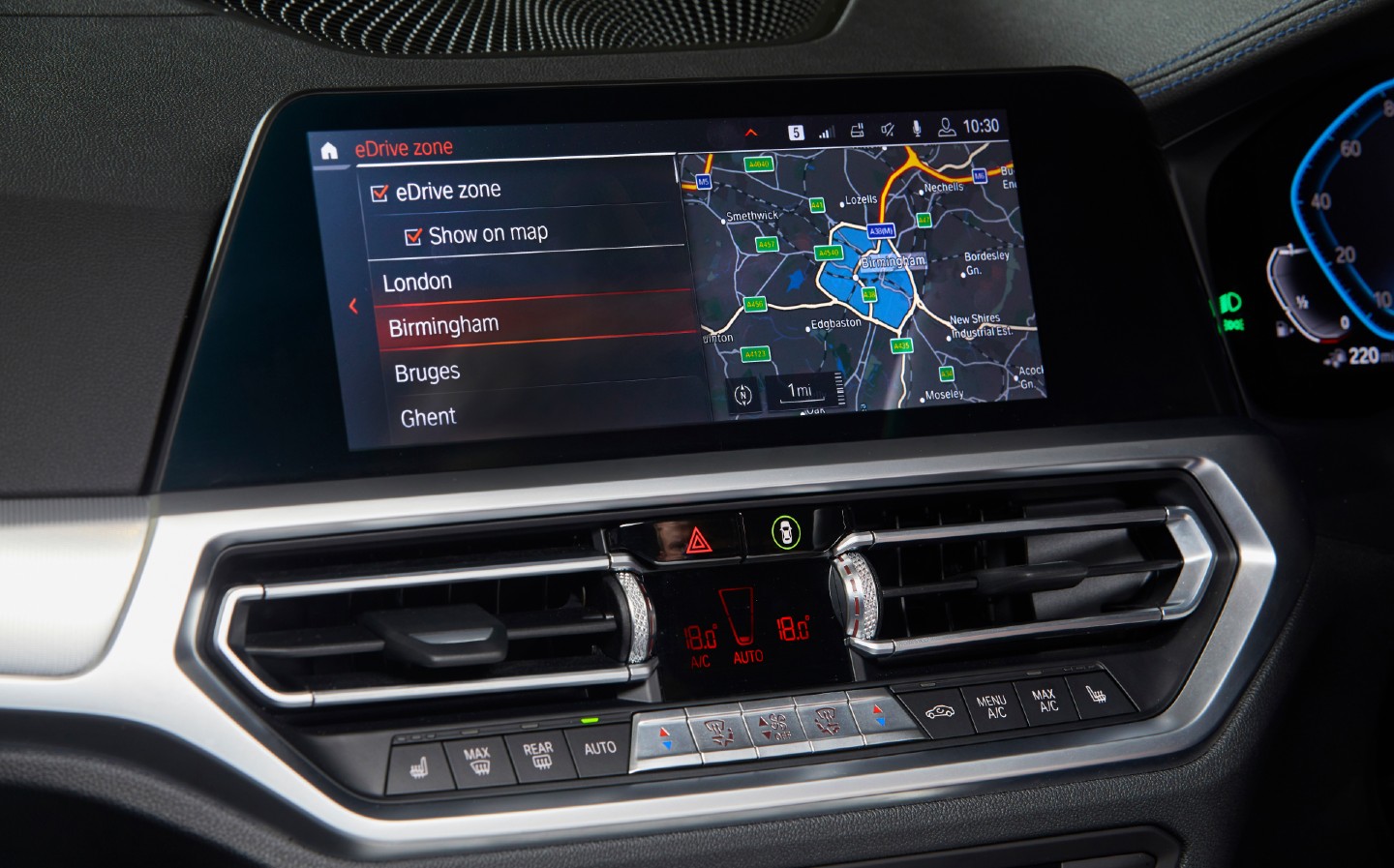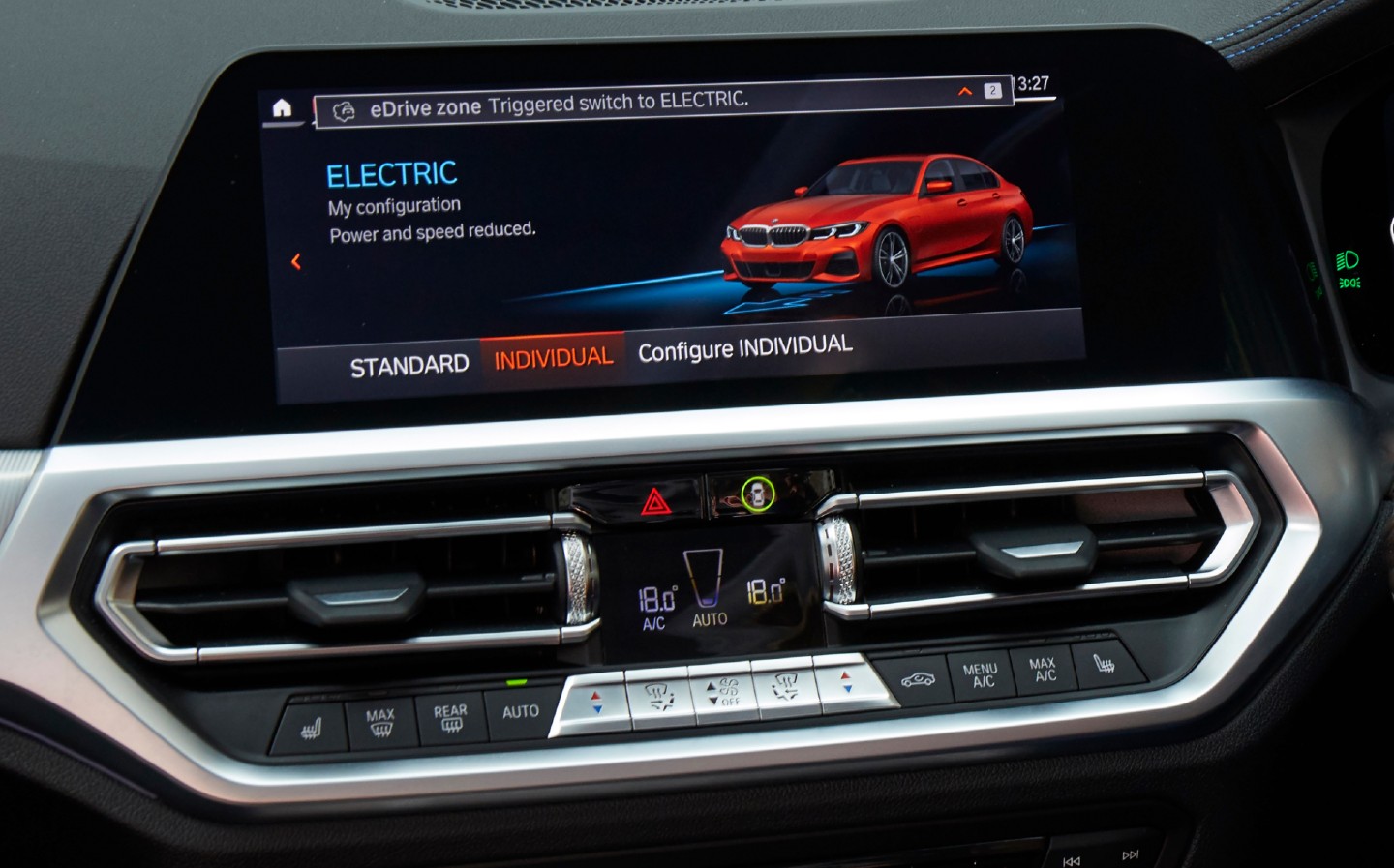BMW eDrive Zones automatically switch hybrid cars to electric mode in cities
Politicians encouraged to see the advantages of plug-in hybrid technology
BMW has introduced new “eDrive Zones” designed to ensure its plug-in hybrid (PHEV) models run in zero-emission electric mode when in cities.
The German car maker is the first manufacturer to use global positioning satellite geo-fencing technology to inform its PHEVs, which combine a petrol engine with a battery-electric propulsion system, when they are entering a designated eDrive Zone. The vehicles then switch off the petrol engine and run in zero-emission mode automatically.
The first two UK cities to adopt the technology, which launches today, are London and Birmingham. In the capital it covers the same geographic area as the TFL Congestion Charge/ Ultra-low Emission Zone, while in Birmingham the service covers the city’s planned Clean Air Zone, which is due to be implemented in 2021. BMW plans to introduce this technology in additional cities across the UK and Ireland in the future, with Glasgow expected to join the scheme in the near future.

The technology is included in every new BMW 3 Series, BMW 5 Series, BMW 7 Series and BMW X5 plug-in hybrid model, which are capable of up to 54 miles of pure-electric driving. It is also available as a free over-the-air software update for existing compatible customer PHEVs that use the company’s new operating System 7.
BMW says the technology is sophisticated enough to know when a route planned via the in-car sat nav involves entering an eDrive Zone, and will prep the car so that it arrives there with maximum electric range. Although the cars can use the petrol engine as a generator to charge the propulsion battery, BMW acknowledges this makes the vehicles less efficient than a standard petrol vehicle. Instead, customers are encouraged to plug in for a mains recharge prior to each journey, and the car will run in standard hybrid mode and hold the full charge until the zone is reached.
PHEVs have come under criticism for being far more polluting than an equivalent petrol, diesel or so-called “self-charging” hybrid when not regularly charged up, as the large battery pack makes them much heavier. A 2018 study by The Miles Consultancy, which conducted an audit of fuel consumption of PHEVs among company car drivers, found that the most popular models from the likes of Mitsubishi, Mercedes, Volkswagen and BMW routinely returned fuel consumption figures up to three times higher than official claims.
Separate studies in Norway and by Emissions Analytics in the UK came to similar conclusions. The increased fuel consumption was found to occur when the cars were not recharged by drivers, meaning the petrol engine is used 100% of the time. Critics noted the ultra-low official CO2 emissions figures, which result in significant tax breaks, especially for company car drivers who have greatly reduced monthly benefit-in-kind payments. The extra cost of fuel from low miles per gallon may still result in a reduction in monthly outgoings when driving a PHEV.
Seemingly recognising this loophole, the government is currently consulting on a ban on sales of new hybrids, along with traditional petrol and diesel cars, from 2035 — or possible even as early as 2032.
However, BMW believes PHEVs, when used correctly, can make a significant contribution to reducing exhaust emissions in cities, and claims an early trial of eDrive Zones in the Netherlands in 2018 resulted in 90% of all routes within the trial zone in Rotterdam being driven in electric-only mode.
In an online briefing yesterday to launch the London and Birmingham eDrive Zones, a BMW spokesperson said it’s the responsibility of car makers and governments to educate drivers on the most efficient ways to drive the vehicles, as plug-in hybrids can offer the best of both worlds, when used as intended. He also said politicians should fully understand the possible emissions reduction benefits for inner-cities.
Wieland Bruch, BMW Group Electromobility spokesperson, said: “A plug-in hybrid, when you don’t charge it, will use at least as much fuel as a conventionally-powered car, so we need to make it clear to all the relevant stakeholders that charging is essential, and we have to communicate more about the advantages customers have when they use the plug-in hybrid according to the technology in it. Here, the example of BMW eDrive Zones shows clearly the advantages the customer has.
“We not only need to make these advantages clear to the users, but also to the city and local authorities, so when we think about legislation or regulating, then these newest opportunities of technology should be made aware to all the stakeholders and decisions should not be made without knowing about latest technology opportunities.”

A BMW spokesperson also said that the introduction of PHEVs with eDrive Zone technology is “step one”, but the next step would be opening up the discussion with politicians about what it could mean for inner-city emissions reduction.
Pieter Nota, BMW AG board member for Customer, Brands, Sales, added: “This is the flexibility that customers want, as they make the transition to electromobility. A plug-in hybrid vehicle combines the best of two worlds: emission-free city-driving as well as long-distance capabilities.
“We urge governments to prioritise plug-in hybrid vehicles in order to encourage consumers to live a more sustainable lifestyle. BMW eDrive Zones technology supports customers to drive emission free in London and Birmingham. It improves air quality in cities fast and reduces running costs for drivers. It’s win-win for everyone.”
BMW Group currently offers 14 electrified vehicles across its brand portfolio, which includes Mini. This will be increased to a total of 25 electrified models on the road by the end of 2023, with more than half of those models pure-electric. In Europe, the BMW Group expects that electrified vehicles will account for 25% of sales by 2021, a third by 2025 and half by 2030.
BMW says it now buys all the lithium and cobalt required for battery production itself, before sending it to the battery plants, ensuring its products are the results of ethical mining practices. The company also claims no rare Earth metals are used, and its battery recycling scheme for end-of-life vehicles will mean packs do not end up in landfill.
Jeremy Clarkson: The Audi Q5 plug-in hybrid proves there are too many drawbacks to going green




